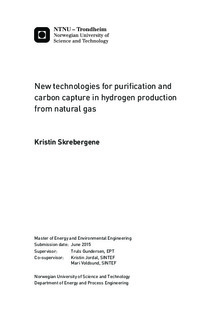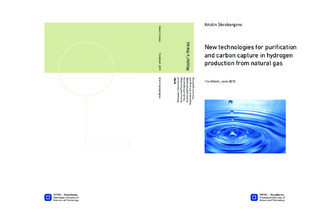| dc.description.abstract | In a society increasingly concerned with environmentally friendly solutions for energy extraction, hydrogen is expected to be an important energy carrier. Hydrogen can originate from various feedstocks, where fossil fuels represent the largest share. Among the fossil fuels, natural gas outperforms the others regarding environmental considerations in hydrogen production. It is of great interest that hydrogen-producing plants are under constant development, related to improved efficiency and reduced emission. This work therefore focuses on potential improvements of the conventional process for hydrogen production from natural gas.
The Autothermal Reforming process (ATR) for hydrogen production is the process under investigation, due to the possibility of capturing the required amount of CO2 through a single separation unit. In order to develop a platform for comparing the conventional ATR process with new and possible improved technology, a case study was developed. The base case of this study comprises the conventional ATR process, containing the reformer, the water-gas shift reactors, the Pressure Swing Adsorption (PSA) unit for hydrogen purification and a solvent process for CO2-removal in front of the PSA. PSA off-gas is sent to a gas turbine for power generation.
Membranes represent a new and optimistic technology when it comes to hydrogen purification. Using membranes for this purpose facilitate CO2-capture downstream. An interesting process concept is therefore to combine the membrane with a following low-temperature separation process for CO2. The main objective for this thesis will consequently be to compare the conventional ATR process with the more unconventional processes, concentrating on membrane solutions in various designs and low-temperature separation processes for CO2-capture.
Four membrane cases are developed, where different solutions for membrane implementation are studied. The cases consider, respectively, implementation of a single membrane module placed after the WGS-unit, a sequential membrane and WGS module, a single membrane case with 20 bar permeate pressure and a combination of the base case and the single membrane case where CO2 removal occurs in front of the membrane. All developed cases aim to be heat-and power integrated, and two membrane feed pressures were investigated, respectively 36 bar and 66 bar.
HYSYS, version 8.3, is used as the primary simulation tool, where all the developed cases are constructed. The tendency of the simulation results is that the case considering a sequential membrane and WGS module performs better than the other studied cases, regarding both the overall plant efficiency and the total CCR. This case stands out as the best solution for hydrogen production. The single membrane process, however, will not provide any advantageous effects compared to the conventional ATR process, except for the fact that membranes generate entirely clean hydrogen. Elevated permeate pressure makes hydrogen compression superfluous. However, 20 bar permeate pressure leads to an unrealistic large membrane area due to lack of driving forces. This was observed through the membrane parametric study carried out. The results for the case considering CO2-removal in front of the membrane module, follows approximately the same trend as the single membrane case, and will not provide any great benefits compared to the conventional ATR process. In addition, this case consumes most power in order to produce the same amount of hydrogen as the other cases. However, the required membrane area will decrease significantly for this case. The decision between the single membrane cases, therefore, becomes a tradeoff between investments costs and operating costs. The conclusion of this works is that the case considering a sequential membrane and WGS module, with two steps, gives the best results, and should be the applied process for hydrogen production. | |

